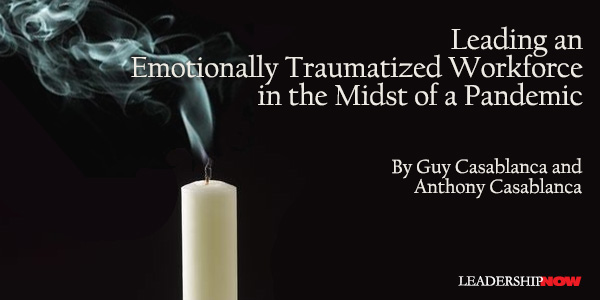 |
 |
10.05.20

Leading an Emotionally Traumatized Workforce in the Midst of a Pandemic
YOUR COMPANY has begun its phased reopening. You are excited to be back in the office and a more normal routine. However, things are not as normal as you thought they would be. Not everyone shares in your enthusiasm, and the culture of your team seems to have changed. Your team is easily distracted and anxious. Even your top performers are not themselves. You are struggling to understand what the issues are and how to address them. Should you allow performance to seek its own level? Should you remind everyone of the previous performance standards and enforce them rigidly? How long do you let the faltering performance continue? The issue you, as the leader, are experiencing is the complexity of grief caused by a global pandemic. Grief is triggered any time a person faces the loss of what they considered to be their normal reality. The pandemic has caused many realities to shift. Some genuine, and some perceived. Many of these changes are losses. Here are some your people may be experiencing:
Grief takes on many shapes and forms. When the global pandemic struck the United States, it was sudden and unnatural. This generation has never experienced anything like this in our lifetime. When losses of loved ones, employment, a home, or anything people have a deep relationship with are sudden and unnatural, the grief experienced is more profound, more prolonged, and more complex. Our psyche does not know how to process these types of losses. All of the instances cited above are the result of the sudden shift in people’s reality. This scenario is playing out in every business and at every level across the country. The result: people are in denial, people are angry, people are bargaining, and people are depressed—all stages of the grief cycle. Professional sports are not even immune to this as players are electing to sit out the abbreviated seasons as a result of the fear that their team will not be able to keep them safe. So how should a leader deal with this situation? As a leader, it is up to you to adapt your leadership style to help guide employees through their new life and work reality. Adaptive leaders are versatile and adept at balancing the five evaluation attributes of their people: stewardship, trust, empowerment, collaboration, and communication frequency. By adjusting your leadership style across these five elements, the adaptive leader helps grieving or emotionally traumatized employees excel at work through times such as these. Adaptive leaders understand that employees who experience an emotionally traumatic event are not the same people when they return to work as they were before the event. Emotionally traumatic events impact both the person's ability to perform and their potential while they work through the event and the subsequent grief emotions. Here are four tips for leading through these times:
We are not suggesting leaders relax performance standards or take a soft approach to leading—quite to the contrary. What we are recommending is the most challenging form of leadership. We are suggesting the leader should confront the issues head-on, but only after genuinely seeking to understand what the issues are from the employee’s point of view. It takes a strong and confident leader to engage people on a personal and emotional level. If you implement these four tips, your team will see you as a compassionate leader who is willing to adapt your style to meet them where they are as they navigate their new realities. Now more than ever, people are looking to their employer to demonstrate that they care about them. How a leader deals with these difficult situations sends a highly visible message. The result will be higher levels of trust in you and the organization, higher morale, higher productivity, and higher levels of loyalty and engagement. We would enjoy hearing about your leadership experiences as they relate to this topic. Visit our website, www.griefleaders.com, and share your story on our contact page.  
Posted by Michael McKinney at 07:02 AM
|
BUILD YOUR KNOWLEDGE
 

How to Do Your Start-Up Right STRAIGHT TALK FOR START-UPS 
Grow Your Leadership Skills NEW AND UPCOMING LEADERSHIP BOOKS 
Leadership Minute BITE-SIZE CONCEPTS YOU CAN CHEW ON 
Classic Leadership Books BOOKS TO READ BEFORE YOU LEAD |